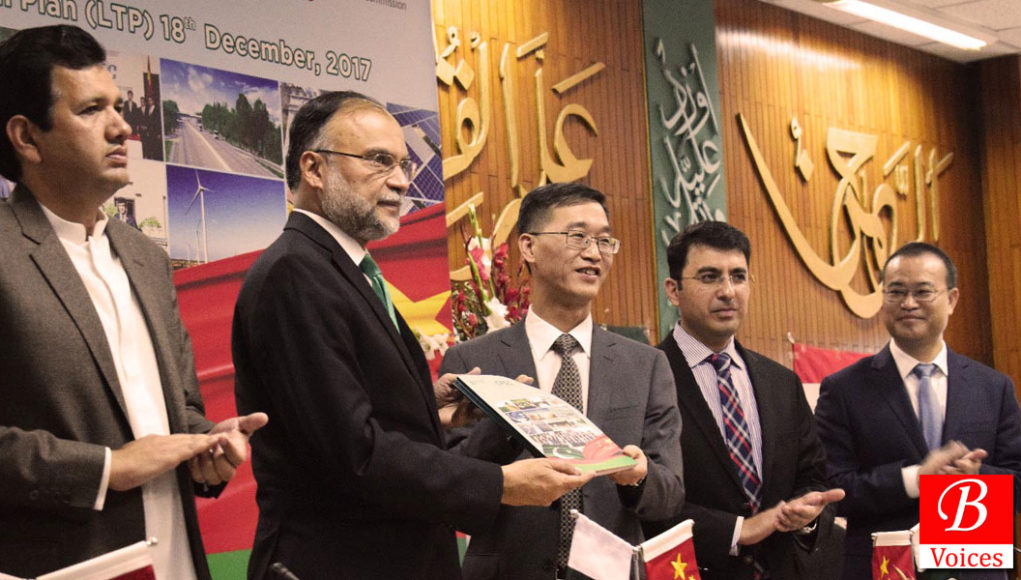After the conclusion of 7th Joint Cooperation Committee (JCC) meeting of China-Pakistan Economic Corridor (CPEC), the pressure increased on the federal government to publically release agreements with China.
As a result, Federal Minister for Planning, Development, and Reform Ahsan Iqbal announced to launch LTP. On, Monday 18th December, Federal Government launched the Long Term Plan (LTP) of CPEC which can be found here. (PDF)
The released LTP disappointed all the pundits and experts who were eagerly waiting for LTP as a key to CPEC mystery. The LTP proved to be a brief document which only contains broad directional points and not precise details.
What’s LTP Entails?
LTP of CPEC from 2017 to 2030 is an agreement between National Development and Reform Commission of China and Ministry of Planning, Development, and Reform of Pakistan, which was signed on 21st November. LTP is a living document and it will be reviewed by both Pakistan and China after every two years.
Read also: Feasibility Report Unprepared: No SEZ Approved for Balochistan in 7th JCC
The 31-page document of LTP states that CPEC was signed in April 2015 and its 1+4 cooperation mode. This means the CPEC comprises of four component which are Gwadar Port, Energy, Transport Infrastructure and Industrial Cooperation. According to the LTP document, The CPEC covers China’s Xinjiang Uygur Autonomous Region and the whole territory of Pakistan.
CPEC comprises of four component which are Gwadar Port, Energy, Transport Infrastructure and Industrial Cooperation
Short Term projects of CPEC till 2020 aim to remove major bottlenecks for economic and social development of Pakistan. Medium term projects till 2025 will aim to build all the major functions of an industrial system in the country. Lastly, long-term projects till 2030 will aim for sustainable economic growth.
Critical Analysis of LTP
Majority of controversies of CPEC are due to the fact that the detailed agreements and nitty-gritty of the projects were not made public before. This LTP also failed to provide any information on the specifics of the projects signed between Pakistan and China. The LTP focused more on economic analysis of future of Pakistan and challenges rather than answering specific questions about the projects of CPEC.
Moreover, the LTP document eloquently lists down general aims and goals in key corporation areas between China and Pakistan. That’s not new and much has been said and written on this. This was not people looking for in the LTP. People wanted to know the specific details of the terms of reference of CPEC projects which have been deliberately kept a secret so far.
Read also: Claims of Development from CPEC are Delusions: Senators from Balochistan
Western Route of CPEC is a major bone of contention in the entire CPEC debate. Politicians of Balochistan and Khyber Pakhtunkhwa (KP) believe that there is no western route whereas federal Government claims that western route is an integral part of CPEC. The LTP document revealed some facts which question the claims of the federal government about the western route. LTP lists down all the node cities in the CPEC. Quetta and Gwadar are the only two node cities in Balochistan. So, if there is any western route then why there is no node city connecting Quetta to Gwadar such as Kalat, Khuzdar, and Turbat and so on.
If there is any western route then why there is no node city connecting Quetta to Gwadar such as Kalat, Khuzdar, and Turbat
Furthermore, one of the most asked questions about CPEC is related to the mode of financing of different projects. Now, CPEC comprise of $62 Billion projects and how this money will be invested? Soft loans, commercial loans, Foreign Direct Investment? Unfortunately, this million dollar question has also not been answered in the released LTP.
This document only mentions that Pakistan and China should reasonably determine the investment and financing modes based on the nature of projects and the status of cash flow. Both the countries shall jointly prepare plans, divide financing responsibilities based on the project situation and their respective investment and financing strength.
This does not reveal anything about the specifics of the mode of financing of the CPEC projects. As a result, all the questions and concerns that CPEC will increase the foreign debt of Pakistan will remain unanswered and source of controversy.
Lastly, the Federal government has been blamed for keeping the detailed agreements of CPEC secret because they want to hide facts from the smaller provinces. It’s alleged that PML-N has shaped up CPEC projects in such a way that Punjab is the largest beneficiary followed by Sindh whereas KP and Balochistan have largely been ignored despite being backward provinces. These allegations will not go away anytime soon because the Federal government failed to share detailed information about CPEC projects in LTP document.
Have something to Say? Use following comments section!
Share your comments!








